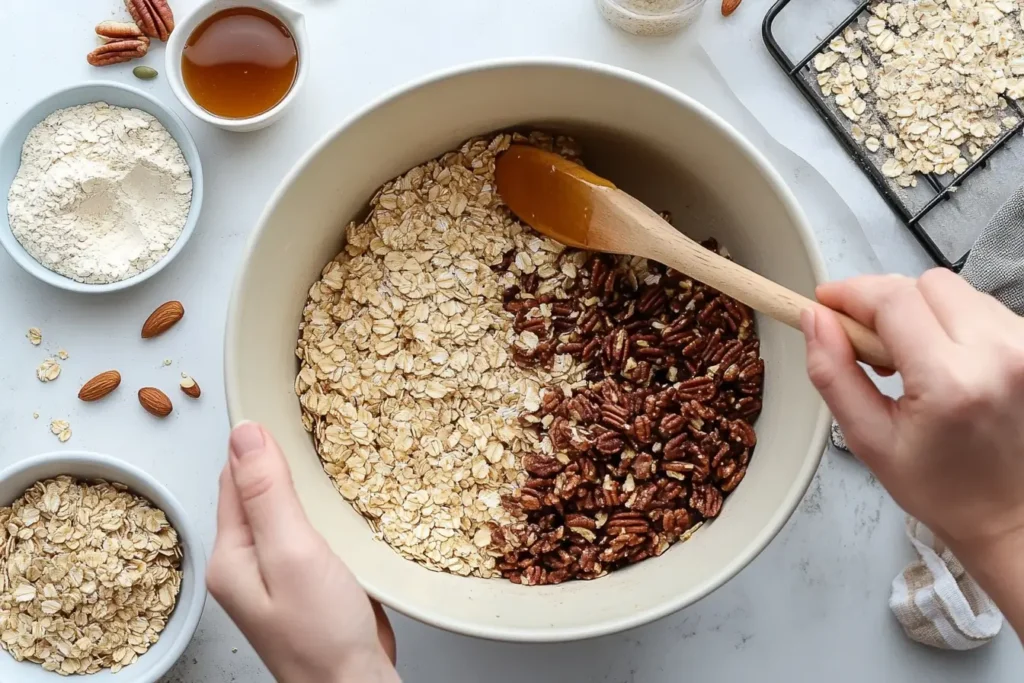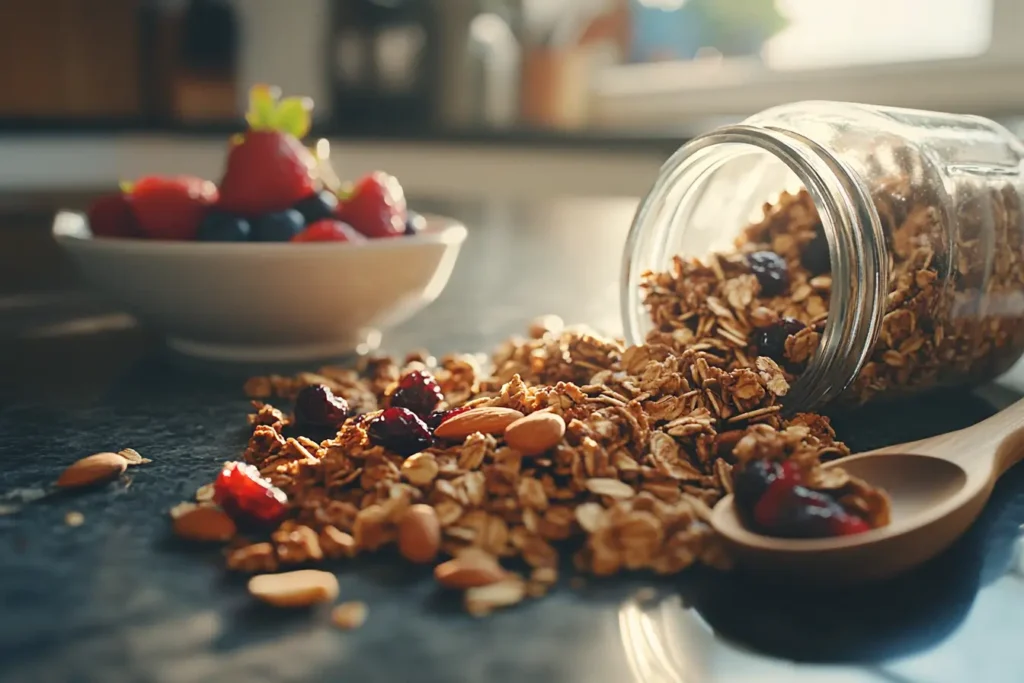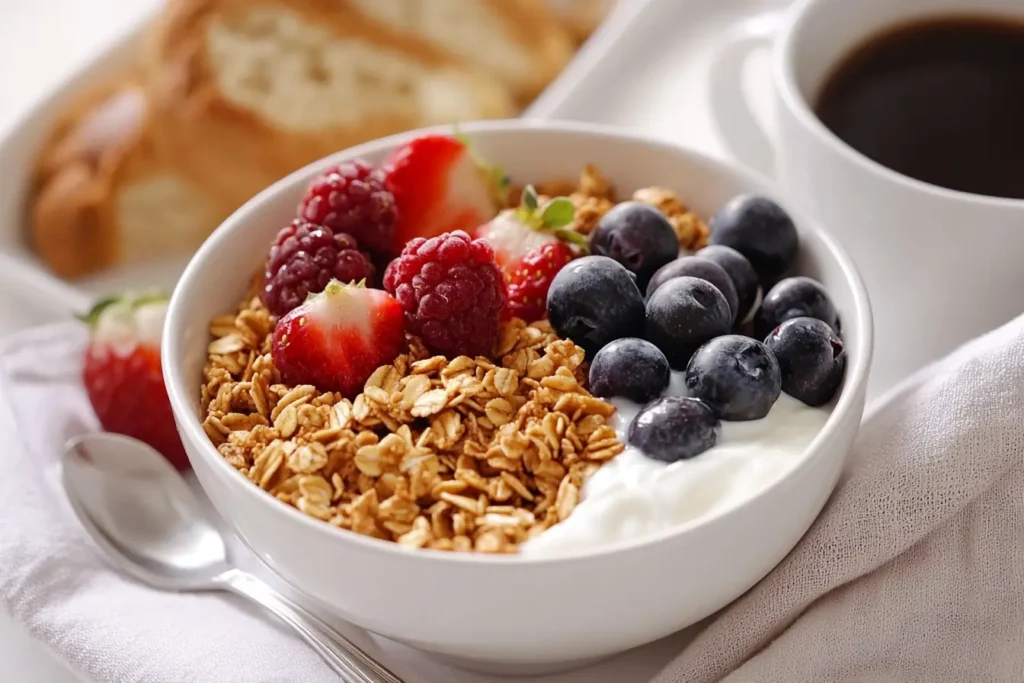Why is homemade granola better than store bought? The answer lies in its superior health benefits, cost savings, and endless customization options. Unlike store-bought varieties packed with refined sugars and preservatives, homemade granola gives you full control over ingredients, ensuring a fresher, more nutritious option. Plus, making it at home reduces packaging waste, supports sustainable choices, and lets you create flavors tailored to your taste. Whether you’re looking for a healthier breakfast, a crunchy snack, or an eco-friendly alternative, homemade granola is the smarter choice in every way.
Table of Contents
Cost Comparison
When it comes to granola, the numbers tell a compelling story. Comparing homemade granola to store-bought options reveals surprising insights into cost-effectiveness.
Homemade Granola: Cost-Effective in the Long Run
At first glance, making granola at home may seem like a splurge. Buying bulk ingredients like oats, nuts, and seeds can add up initially. However, these ingredients stretch far, allowing you to make multiple batches and reducing the cost per serving significantly. For instance, spending $15 on ingredients can yield around 30 servings of homemade granola, bringing the cost per serving down to as low as $0.50. That’s half the price of most store-bought granola, which hovers around $1 per serving.
Beyond saving money, homemade granola eliminates the need for continuous purchases, making it a budget-friendly option for families or granola enthusiasts.
Hidden Costs in Store-Bought Options
Store-bought granola, on the other hand, comes with hidden costs you might not immediately notice. You’re paying for the fancy packaging, branding, and convenience, which all inflate the price. Plus, these products are often sold in smaller quantities, meaning you’ll have to buy more frequently. Over time, these extra expenses pile up.
Let’s not forget the leftovers. When you make granola at home, you’ll have extra oats, seeds, and nuts for future batches or other recipes, further increasing the value of your initial investment.
Health Benefits of Homemade Granola
Granola often gets a health halo, but not all granola is created equal. When comparing homemade granola with store-bought, the health advantages of going the DIY route are clear.
Controlling Sugar Content
One of the biggest benefits of making granola at home is the ability to control what goes into it. Many store-bought granolas are loaded with refined sugars like high-fructose corn syrup, brown sugar syrup, or tapioca syrup. While these sweeteners add flavor, they can also contribute to unhealthy weight gain and spikes in blood sugar. By making granola at home, you can use natural sweeteners like honey, maple syrup, or dates, giving it a sweet touch without overloading on sugar.
Increasing Nutrient Density
Store-bought granolas often skimp on nutrient-dense ingredients, opting for fillers instead. Homemade granola, on the other hand, allows you to pack in fiber-rich oats, protein-packed nuts, and seeds like chia or flax. These ingredients not only boost satiety but also provide essential nutrients like omega-3 fatty acids, which are great for your heart and brain health. Plus, adding dried fruits like raisins or apricots introduces vitamins and minerals that many commercial options lack.
Avoiding Preservatives
Commercial granolas are designed for long shelf lives, often containing additives and preservatives. These chemicals might extend the granola’s freshness but don’t contribute to your health. Homemade granola, made in small batches, is free from these unwanted extras. It’s fresher, tastier, and better for your body.
If you’re curious about how specific ingredients can enhance granola’s health benefits, check out this guide on What Ingredient Makes Granola Stick Together?.
Customization and Flavor

One of the joys of making granola at home is the freedom to experiment. When you take control of your granola, the possibilities are endless.
Tailoring Recipes to Dietary Needs
Do you follow a gluten-free, vegan, or low-carb diet? Store-bought granolas may not cater to specific dietary needs, but homemade granola can. Swap out oats for gluten-free varieties or use coconut oil instead of butter. You can even add extra protein through almond butter or seeds, turning your granola into a post-workout snack.
Experimenting with Flavors and Textures
The beauty of homemade granola lies in its versatility. You can customize flavors to suit your taste buds—think cinnamon and nutmeg for a cozy vibe, or coconut and dried mango for a tropical twist. Playing with textures is just as fun. Add crunch with toasted nuts or go chewy with dried fruits. Store-bought granola may offer variety, but nothing beats the creative freedom of making your own.
For flavor inspiration, try this Vanilla Nut Granola Recipe that’s both simple and delicious.
Environmental Impact
In a world increasingly focused on sustainability, the environmental benefits of making granola at home cannot be overstated. Beyond just being healthier and tastier, homemade granola is also kinder to the planet.
Reducing Packaging Waste
Store-bought granolas often come in single-use plastic bags or boxes with plastic liners, contributing significantly to landfill waste. On the other hand, making granola at home allows you to minimize packaging entirely. Buying ingredients in bulk and storing your homemade granola in reusable jars or containers drastically cuts down on plastic use.
By choosing to go the DIY route, you’re not just saving money but also reducing your ecological footprint. It’s a small change that adds up over time, especially for those who regularly consume granola.
Sourcing Local Ingredients
Another eco-friendly advantage of homemade granola is the ability to source local ingredients. Supporting local farmers and buying oats, honey, or nuts from nearby suppliers reduces the carbon emissions associated with transporting goods over long distances. Locally sourced ingredients are often fresher, too, making your granola even more delicious.
For an in-depth guide on sourcing the best ingredients for your granola, you might enjoy our recipe article on Vanilla Nut Granola.
Time and Convenience Trade-Offs

While homemade granola has plenty of benefits, it does require a bit of time and effort. Let’s break down the time and convenience factors for both options.
Effort Required for Homemade Granola
Making granola at home involves several steps—buying ingredients, mixing them, baking, and cleaning up. Depending on the recipe, it can take anywhere from 30 minutes to an hour to make a batch. For people with busy schedules, this may seem like a hurdle. However, once you’ve made granola a few times, the process becomes second nature, and you can prepare large batches that last for weeks.
Plus, the control over ingredients and flavors makes the time investment worthwhile. You can also explore helpful tips on improving your homemade granola’s texture in our article on Why Are Homemade Granolas Not Crunchy?.
When Convenience Matters
Store-bought granola, on the other hand, is as easy as grabbing a bag off the shelf. For those juggling hectic lifestyles, this convenience can’t be beaten. But keep in mind that convenience comes at a cost—not just financially, but in terms of added sugars, preservatives, and less environmentally friendly packaging.

FAQs
Still curious about why homemade granola is better than store bought? Here are answers to some of the most commonly asked questions.
Is Homemade Granola Healthier Than Store-Bought?
Absolutely! Homemade granola lets you take full control of the ingredients. You can avoid refined sugars, artificial preservatives, and fillers commonly found in store-bought options. Instead, you can choose wholesome ingredients like oats, nuts, seeds, and natural sweeteners. The result is a granola that’s not just tastier but also more aligned with your health goals.
How Long Does Homemade Granola Last?
Homemade granola typically lasts 2–4 weeks when stored in an airtight container at room temperature. To extend its shelf life, keep it in the fridge, where it can stay fresh for up to 6 weeks. The absence of preservatives means it won’t last as long as store-bought options, but it’s worth the effort for the better quality and taste.
What Are Some Easy Homemade Granola Recipes?
If you’re new to making granola, start with simple recipes like vanilla almond or cinnamon spice granola. These recipes require minimal ingredients and deliver fantastic flavor. For a delicious recipe idea, check out our Vanilla Nut Granola Recipe.
Does Homemade Granola Save Money?
Yes, especially in the long run. Although the initial cost of buying ingredients may seem higher, you’ll save more over time by making multiple batches. Plus, homemade granola gives you the flexibility to buy ingredients in bulk, which further reduces costs.
Conclusion
After diving deep into the benefits of making granola at home, it’s clear that choosing homemade over store-bought is a decision packed with advantages. From cost savings and better nutrition to customization and sustainability, homemade granola stands out as the superior option.
A Smarter Choice for Health
One of the most compelling reasons why homemade granola is better than store bought is its undeniable health benefits. Unlike commercial granola, which often contains excessive amounts of refined sugar, artificial flavors, and preservatives, homemade granola allows you to use high-quality, nutrient-dense ingredients.
With homemade granola, you control the amount and type of sweeteners, making it easier to avoid hidden sugars that can lead to energy crashes and weight gain. Instead of high-fructose corn syrup or refined sugar, you can opt for natural alternatives like honey, maple syrup, or mashed bananas for a touch of sweetness. You can also incorporate nutrient-rich ingredients like almonds, walnuts, chia seeds, or flaxseeds—none of which are guaranteed in store-bought varieties.
Additionally, homemade granola gives you the freedom to make it gluten-free, dairy-free, or keto-friendly, ensuring that it aligns perfectly with your dietary needs. This level of personalization is impossible with store-bought options, which often contain ingredients that may not fit your specific health goals.
Cost-Effective and Budget-Friendly
At first glance, it may seem like buying granola from the store is the easier and cheaper option, but over time, homemade granola proves to be more cost-effective. Store-bought granola often comes in small packages with inflated prices due to branding, packaging, and distribution costs.
On the other hand, when you make granola at home, you buy ingredients in bulk, significantly reducing the cost per serving. A one-time investment in high-quality oats, nuts, and seeds can last for multiple batches, giving you more granola for less money. Additionally, you won’t be paying extra for unnecessary fillers and additives that manufacturers include in commercial granola to extend shelf life or enhance flavor artificially.
Superior Taste and Customization
Store-bought granola might offer a few standard flavors, but they rarely match the depth and freshness of homemade granola. When making your own, you get to experiment with various spices, nuts, dried fruits, and sweeteners to craft a unique blend that suits your taste.
For instance, if you love a warm, spiced flavor, you can add cinnamon, nutmeg, or even pumpkin spice. Prefer a tropical twist? Coconut flakes, dried mango, and macadamia nuts can give your granola a refreshing, exotic taste. Want something indulgent? Dark chocolate chunks, cocoa powder, and roasted hazelnuts can turn it into a guilt-free treat.
Customization extends beyond flavors—you can control the texture as well. Whether you like your granola crunchy and clumped together or loose and airy, making it at home gives you the power to perfect it every time.
A Sustainable and Eco-Friendly Option
Another reason why homemade granola is better than store bought is its positive impact on the environment. Most store-bought granolas come in single-use plastic packaging that contributes to landfill waste. By making your own granola at home, you can store it in reusable glass jars or eco-friendly containers, cutting down on plastic consumption.
Furthermore, you can source your ingredients locally, reducing the carbon footprint associated with transporting packaged granola from manufacturers to retailers. Supporting local farmers by purchasing organic oats, honey, or nuts helps promote sustainable farming practices and ensures fresher, higher-quality ingredients in your granola.
A Lifestyle Change Worth Making
Ultimately, choosing homemade granola is more than just a food preference—it’s a shift toward a healthier, more sustainable lifestyle. Taking the time to make your own granola fosters a deeper connection to what you eat. You become more mindful of your ingredients, reduce reliance on processed foods, and enjoy the satisfaction of creating something wholesome with your own hands.
Additionally, making granola at home can become a fun family tradition. Kids can help mix ingredients and choose their favorite add-ins, turning it into an enjoyable bonding experience. Not only do they learn about healthy eating, but they also develop an appreciation for homemade food.
Final Thoughts
Now that you know why homemade granola is better than store bought, it’s time to take the first step. Start with a simple recipe, experiment with flavors, and make it a regular part of your meal prep. Whether you enjoy it for breakfast, as a snack, or as a topping for yogurt and smoothie bowls, homemade granola is a delicious, nutritious, and budget-friendly choice.
By making the switch to DIY granola, you’re not only benefiting your health but also making a positive impact on the environment and your wallet. So, what are you waiting for? Grab your favorite ingredients and start creating the perfect homemade granola today!
Dernière mise à jour : 08 February 2025

